A bread warmer can describe a number of different devices used to keep bread from cooling too fast. Examples include baskets with cloths, ceramic disks, or cabinets placed over a heat source such as steam radiators.
A bread warmer can describe a number of different devices used to keep bread from cooling too fast. Examples include baskets with cloths, ceramic disks, or cabinets placed over a heat source such as steam radiators.
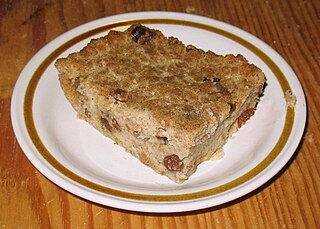
Bread pudding is a bread-based dessert popular in many countries' cuisines. It is made with stale bread and milk or cream, generally containing eggs, a form of fat such as oil, butter or suet and, depending on whether the pudding is sweet or savory, a variety of other ingredients. Sweet bread puddings may use sugar, syrup, honey, dried fruit, nuts, as well as spices such as cinnamon, nutmeg, mace, or vanilla. The bread is soaked in the liquids, mixed with the other ingredients, and baked.

Caraway, also known as meridian fennel and Persian cumin, is a biennial plant in the family Apiaceae, native to western Asia, Europe, and North Africa.

Naan is a leavened, oven-baked or tawa-fried flatbread. It is characterized by its light and slightly fluffy texture and golden-brown spots from the baking process. Naan is found in the cuisines mainly of Iran, Afghanistan, Central Asia, the Indian subcontinent, Indonesia, Malaysia, Myanmar, and the Caribbean.
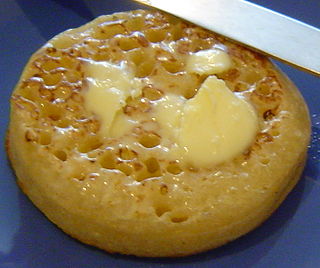
A crumpet is a small griddle bread made from an unsweetened batter of water or milk, flour, and yeast, popular in the United Kingdom, Australia, Canada, New Zealand, and South Africa.
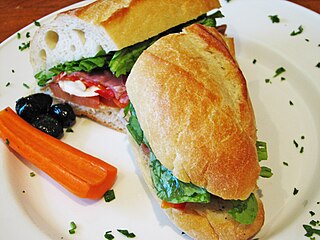
A panini is a sandwich made with Italian bread, usually served warm after grilling or toasting.
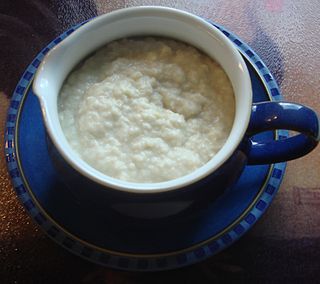
A bread sauce is a British warm or cold sauce made with milk, which is thickened with bread crumbs, typically eaten with roast chicken or turkey.

Smørrebrød, smørbrød "butter bread" (Norwegian), or smörgås "butter goose" (Swedish), is a traditional open-faced sandwich in the cuisines of Denmark, Norway and Sweden that usually consists of a piece of buttered rye bread, topped with commercial or homemade cold cuts, pieces of meat or fish, cheese or spreads, and garnishes.

In cooking, kneading is a process in the making of bread or dough, used to mix the ingredients and add strength to the final product. It allows the process of baking to be shortened by developing the gluten more quickly than it would develop in the absence of kneading.

A teacake in England is generally a light yeast-based sweet bun containing dried fruit, typically served toasted and buttered. In the U.S. teacakes can be cookies or small cakes. In Sweden, they are soft, round, flat wheat breads made with milk and a little sugar, and used to make buttered ham or cheese sandwiches. In India and Australia, a teacake is more like a butter cake. Tea refers to the popular beverage to which these baked goods are an accompaniment.
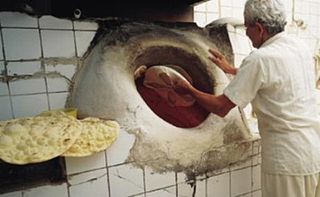
Khubz, alternatively transliterated as khoubz, khobez, khubez, or khubooz, is the usual word for "bread" in Standard Arabic and in many of the vernaculars.

In cooking, proofing is a step in the preparation of yeast bread and other baked goods in which the dough is allowed to rest and rise a final time before baking. During this rest period, yeast ferments the dough and produces gases, thereby leavening the dough.
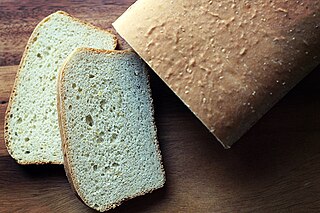
Salt-rising bread is a dense white bread that is traditional in the Appalachian Mountains, leavened by naturally occurring wild bacteria rather than by yeast. Salt-rising bread is made from wheat flour; a starter consisting of either water or milk and corn, potatoes or wheat; and minor ingredients such as salt and sugar.[1] Some common ways of eating salt-rising bread include a slice with sugared coffee poured over it, a grilled cheese sandwich, and the most popular preference, buttered toast.[1]
Hoppang is a warm snack that is sold throughout South Korea. It is a convenience food version of jjinppang and is typically filled with smooth, sweetened red bean paste.

Smörgåsbord is a buffet-style meal of Swedish origin. It is served with various hot and mainly cold dishes.

Traditional Yamal cuisine is an important part of national culture of Nenets, Khanty and Komi. Yamal is a hunting and fishing land so many dishes include meat, fowl and fish. Berries and mushrooms are also abundant; this accounts for the wealth of "gifts of the forests" on the Yamal table. Presently, Yamal cuisine is renowned for diverse delicacies of Russian cuisine. Yamal hosts enjoy treating their guests with traditional Yamal cuisine and have hot tea which came to Yamal cuisine from Russia. Tea has become the national Yamal beverage, drunk to warm and soothe. Yamal is in northern Russia with frigid winters, so its cuisine should be nourishing to give the people energy to survive during the long winter time. The essential component of Yamal cuisine is warm and hot dishes. Fresh fruits and vegetables are rarely used as they must be imported, as they are not grown in the tundra. The Yamal cuisine is associated with malosol and stroganina. Yamal cuisine has absorbed techniques from other regions. Yamal cuisine is based on reindeer meat and fish of the Yamal rivers, enriched with mushrooms and bread.
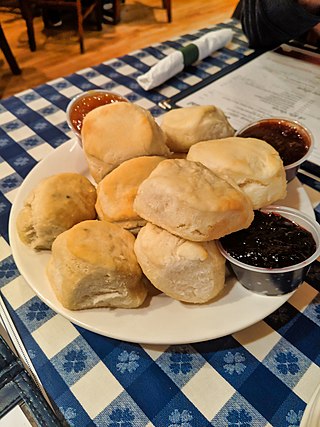
In the United States and Canada, a biscuit is a variety of baked bread with a firm, dry exterior and a soft, crumbly interior. It is made with baking powder as a leavening agent rather than yeast, and at times is called a baking powder biscuit to differentiate it from other types. Like other forms of bread, a biscuit is often served with butter or other condiments, flavored with other ingredients, or combined with other types of food to make sandwiches or other dishes.

Žemlovka, žemľovka or Scheiterhaufen is a sweet bread pudding made of apples and rohlíks or veka, soaked in sweet milk.

Gyeran-ppang is a warm street snack sold throughout South Korea. The fluffy, oblong-shaped loaf of bread is sweet and savory with a whole egg inside the pancake dough.

Bubur kacang hijau, abbreviated burjo, is a Southeast Asian sweet porridge (bubur) made from mung beans, coconut milk, and palm sugar or cane sugar. The beans are boiled till soft, and sugar and coconut milk are added.

Roti bakar, also known as roti kahwin, refers to a type of toast bread in maritime Southeast Asia, usually prepared with grilled white bread, in both the Indonesian and Malay languages. The dish is a popular breakfast food as well as tea time snack in countries like Brunei, Indonesia, Malaysia and Singapore. Historically, roti bakar was grilled or toasted by using charcoal as a heat source in many communities throughout the region, though this practice has dwindled with the advent of modern technology.